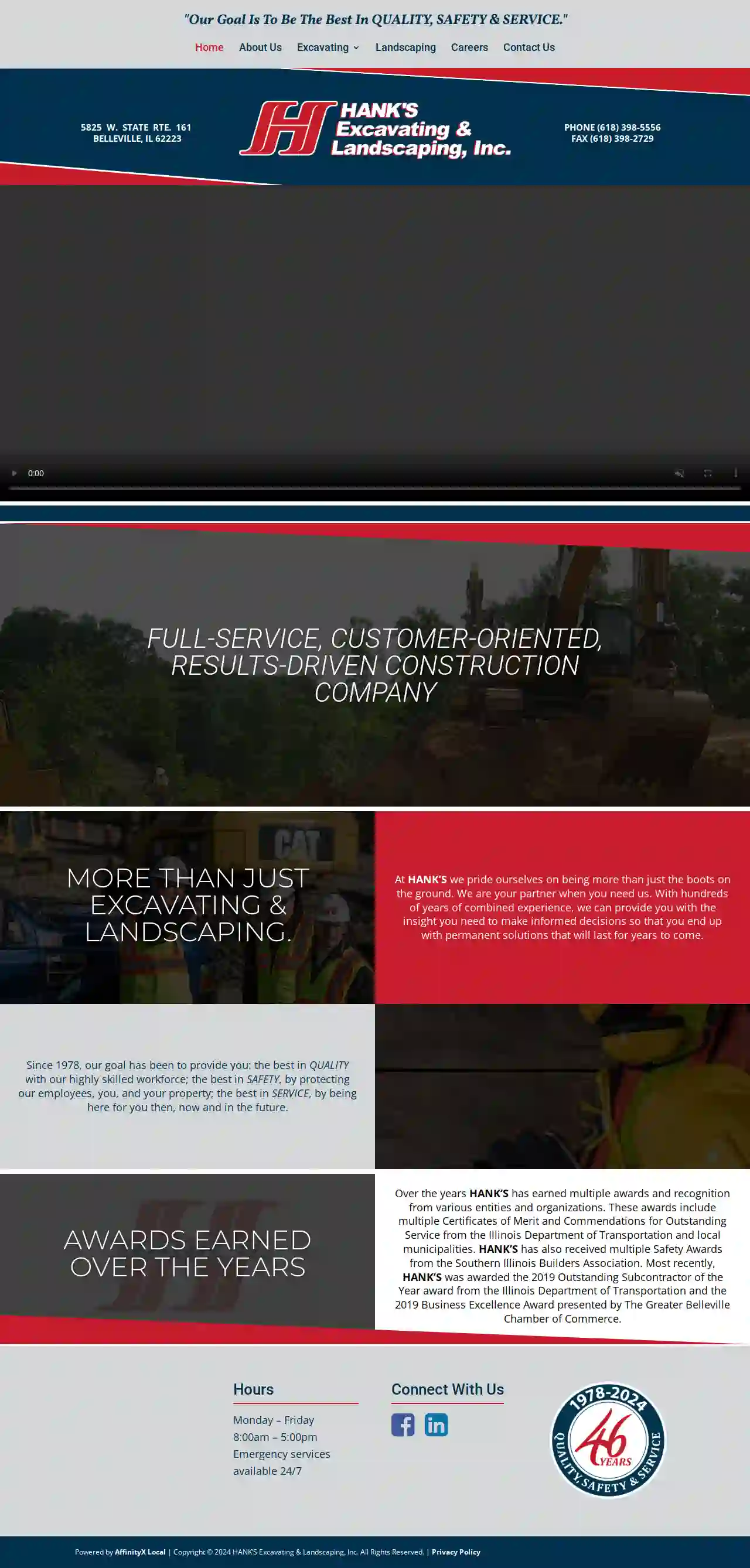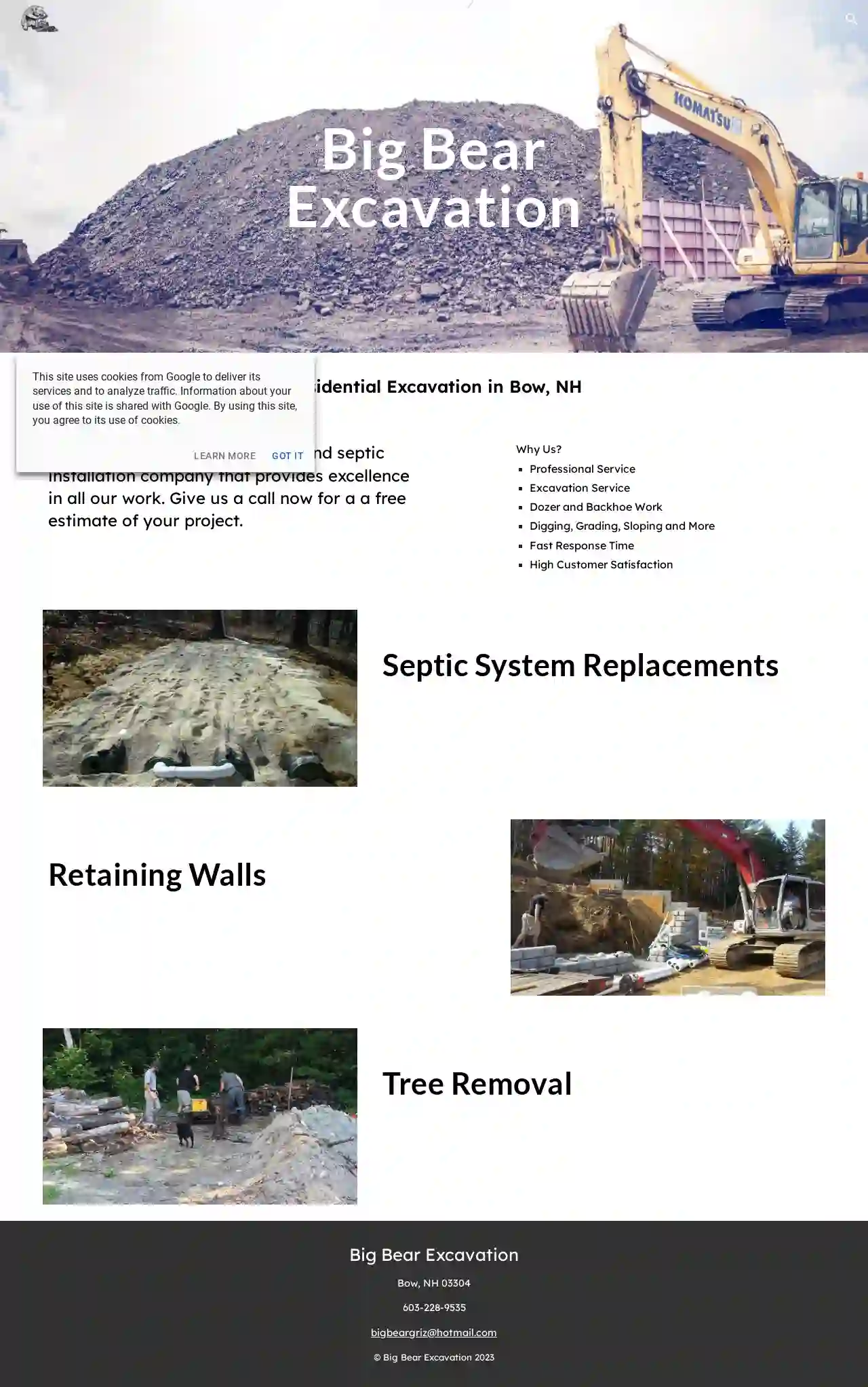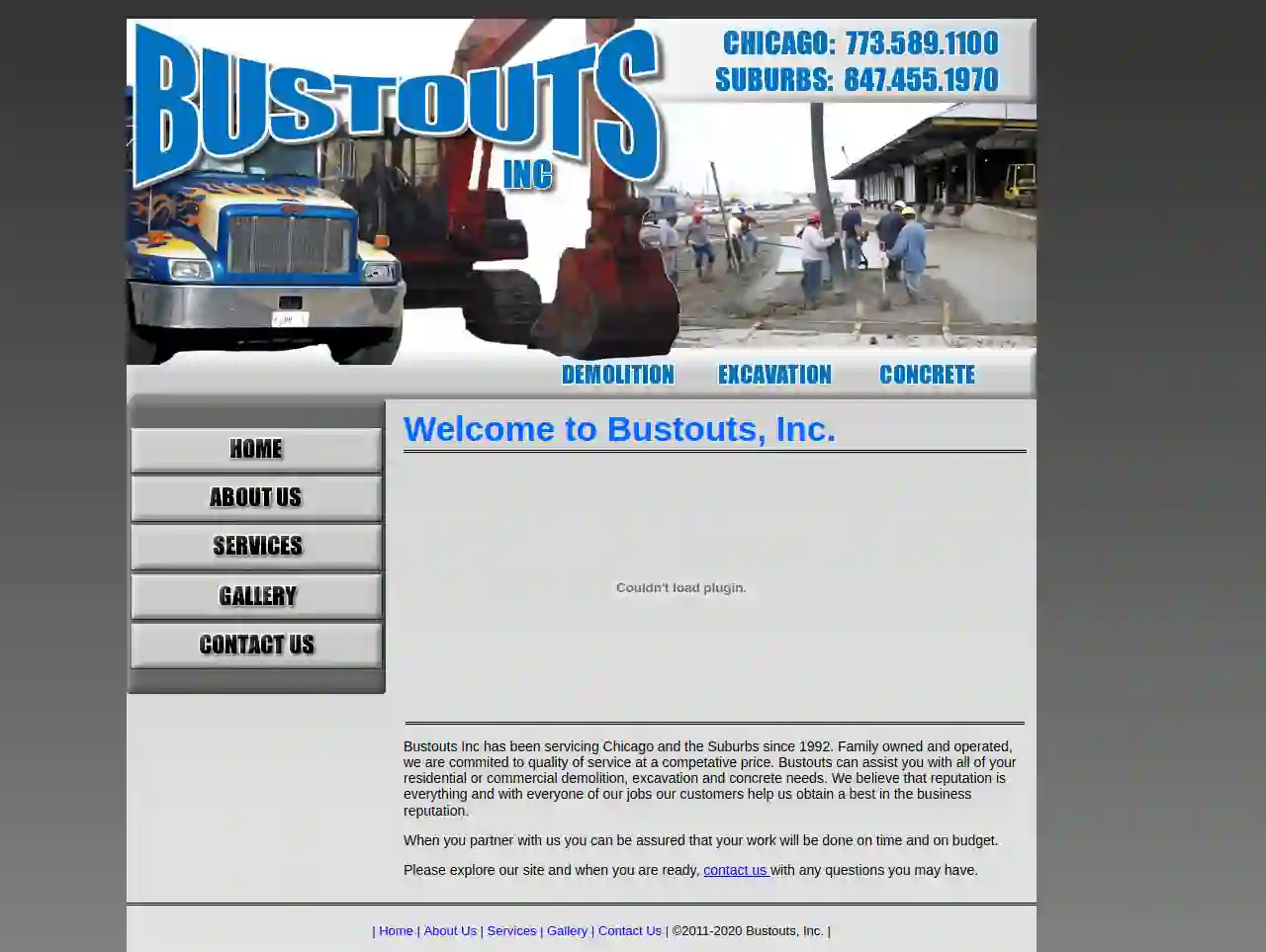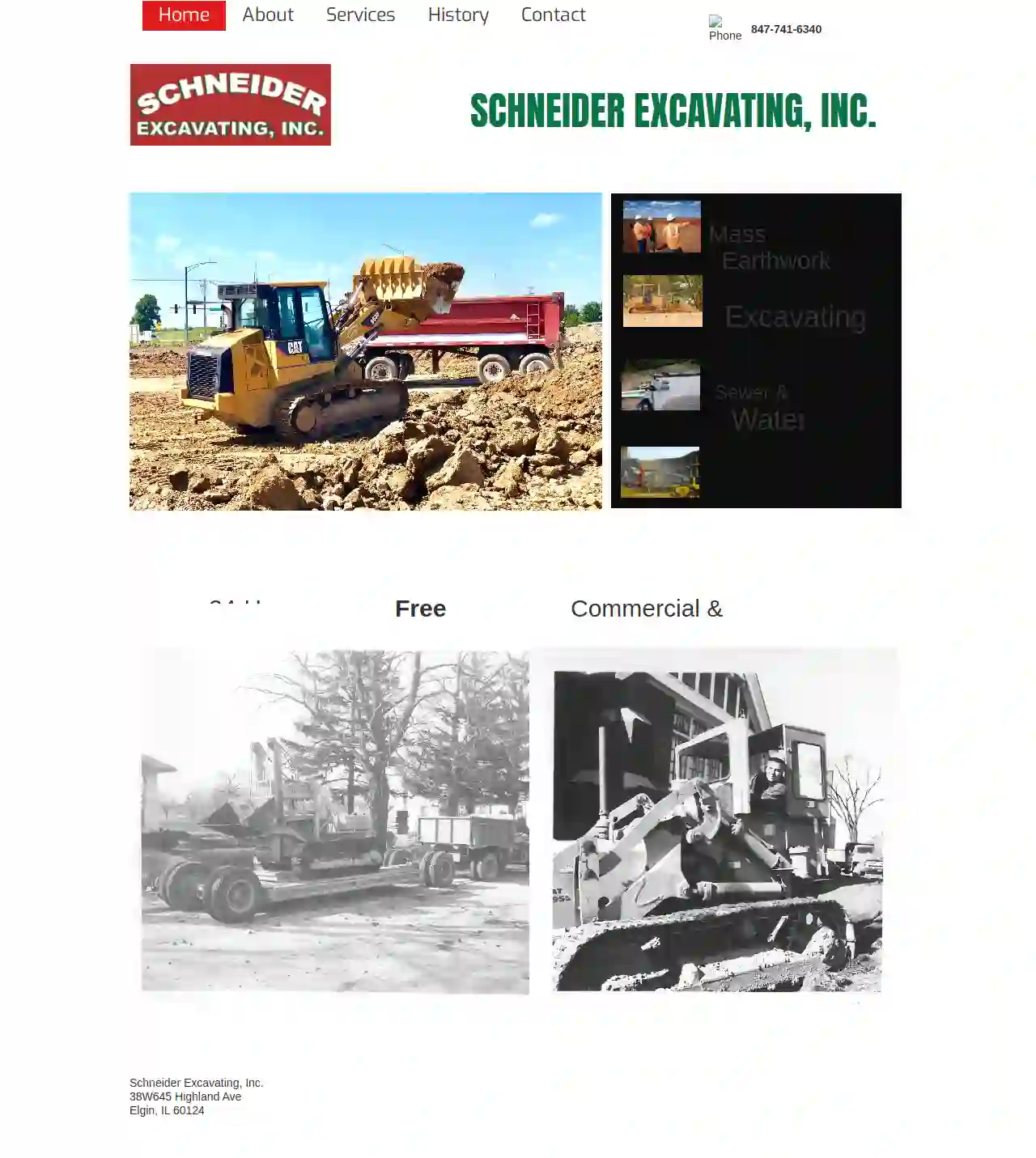Excavation Contractors Manteno
Find Land Excavation in Manteno
Receive up to 3 Trenching Services quotes for your project today! Compare profiles, reviews, accreditations, portfolio, etc... and choose the best offer.

Hank's Excavating & Landscaping Inc
315 reviews5825 W. State Rt. 161, Belleville, 62223, USMore than just Excavating & Landscaping. At HANK’S, we pride ourselves on being more than just the boots on the ground. We are your partner when you need us. With hundreds of years of combined experience, we can provide you with the insight you need to make informed decisions so that you end up with permanent solutions that will last for years to come. Since 1978, our goal has been to provide you: the best in QUALITY with our highly skilled workforce; the best in SAFETY, by protecting our employees, you, and your property; the best in SERVICE, by being here for you then, now and in the future. Building the project is only one aspect of what we do Since 1978, our goal has been to provide you: the best in QUALITY with our highly skilled workforce; the best in SAFETY, by protecting our employees, you, and your property; the best in SERVICE, by being here for you then, now and in the future. Awards earned over the years Over the years HANK’S has earned multiple awards and recognition from various entities and organizations. These awards include multiple Certificates of Merit and Commendations for Outstanding Service from the Illinois Department of Transportation and local municipalities. HANK’S has also received multiple Safety Awards from the Southern Illinois Builders Association. Most recently, HANK’S was awarded the 2019 Outstanding Subcontractor of the Year award from the Illinois Department of Transportation and the 2019 Business Excellence Award presented by The Greater Belleville Chamber of Commerce.
- Services
- Why Us?
- Gallery
Get Quote
J.G Gagnon & Son's Excavation L.L.C
44 reviewsEpping, New Hampshire, United States, USJ.G. GAGNON & SON’S EXCAVATION L.L.C. We take pride in all the jobs we do. With 30 years of experience and pristine work ethics, we give every customer and job 200%. We have a passion, not only for the excavation work itself but, for our customers and their satisfaction! We treat and tackle every job as if it was our own. We take extreme pride in our finished product, always leaving our customers completely satisfied. We’re a small business located in Southern NH and offer services in -
- Services
- Why Us?
- Gallery
Get Quote
Big Bear Excavation
51 reviewsBow, 03304, USBig Bear Excavation We are a residential excavation and septic installation company that provides excellence in all our work. Give us a call now for a free estimate of your project. Why Us? Professional Service Excavation Service Dozer and Backhoe Work Digging, Grading, Sloping and More Fast Response Time High Customer Satisfaction Septic System Replacements Retaining Walls Tree Removal
- Services
- Why Us?
- Gallery
Get Quote
BMB Excavation LLC
44 reviewsNorthwood, USBMB Excavation LLC BMB Excavation LLC is a fully insured, professional company with years of experience, located in Northwood NH. We specialize in a wide variety of services in residential and commercial work, such as septic system, foundation, sewer, water, drains, utilities, and excavation. We work hard with homeowners and contractors to meet deadlines on all projects and tasks, we strive on getting passed challenging obstacles to insure the same vision or goals. Our mission is to provide quality service to customers and contractors and build professional relationship to obtain same vision, plan, and goal.
- Services
- Why Us?
- Testimonials
- Gallery
Get Quote- Ry
Ryan Excavating
51 reviewsChicago, USFacebook is a social networking service and website launched in February 2004, owned by Meta Platforms. It is the largest social network in the world, with over 2.91 billion monthly active users as of the first quarter of 2023. Users can create a personal profile, add other users as friends, and exchange messages, photos, and videos. Facebook is also used by businesses to connect with customers and promote their products and services. The site has been criticized for its role in the spread of misinformation, its impact on mental health, and its privacy practices.
- Services
- Why Us?
- Gallery
Get Quote 
Bust Outs Inc
32 reviewsChicago, USAbout Bustouts, Inc. Bustouts Inc has been serving Chicago and the suburbs since 1992. As a family-owned and operated business, we are committed to providing high-quality services at competitive prices. We specialize in residential and commercial demolition, excavation, and concrete work. Our reputation is everything, and we strive to deliver exceptional results on every project, ensuring customer satisfaction and building a strong reputation in the industry. When you choose Bustouts, Inc., you can trust that your project will be completed on time and within budget. Explore our website to learn more about our services and don't hesitate to contact us with any questions you may have.
- Services
- Why Us?
- Gallery
Get Quote
Wilder Excavating LLC
52 reviews126 Kennedy Brook Drive, Stoddard, 03464-4514, USWelcome to Wilder Excavating! Located in Southwestern NH, Wilder Excavating is a locally family-owned business serving the Monadnock Region and surrounding areas. We work with both residential and commercial customers. At Wilder Excavating, we take great pride in our hands-on experience, expertise, quality, and customer service. It is our mission to provide excellent workmanship and complete customer satisfaction from the start to finish of your project. We understand every customer has different needs. We take time to meet with you, evaluate your project and give you options based on your needs and budget. We take great care to work and communicate with every customer in a professional manner. Our reputation is based on service, safety, and quality, regardless of how large or small the job. Ben from Wilder excavating is nothing short of a solid human being. I have used them multiple times for material sourcing, material delivery, heavy equipment trucking, and advice so I can plan for future projects. Never once was there an issue with any of our interactions regardless of the amount of money changing hands. I recommend them to anyone I know in the region that needs their many services. - Eddie FREE ESTIMATES Need a new lawn, driveway, culvert, septic system … or something needing an excavator… and have no idea what to budget? We are happy to come to you to evaluate the job, and give you pricing… with NO OBLIGATION on your part to hire us for the job. Depending on your needs, we will often give additional options… which you may not have thought about to make the end project better and still be within or under a price range that will fit your budget. We stand behind our work and our pricing. Financing options are available for qualified individuals, if needed. Call for a FREE ESTIMATE (603) 313-5591
- Services
- Why Us?
- Testimonials
- Gallery
Get Quote
Schneider Excavating Inc.
52 reviews38W645 Highland Ave, Elgin, 60124, USAbout Schneider Excavating, Inc. Established in 1932, Schneider Excavating, Inc. strives to be the go-to company for all your excavation needs. We specialize in Mass Earthwork, Excavating, Sewer & Water, and Demolition, offering a level of expertise that sets us apart from other contractors. With over 85 years of experience, we've become experts in excavating for virtually any project. Beyond our contracting certifications, we adhere to strict industry guidelines, incorporating standards set by the EPA and OSHA. This commitment ensures every project detail is addressed, resulting in exceptional work. We are dedicated to doing right by those who place their trust in us. Proudly serving Elgin & the Fox Valley since 1932, Schneider Excavating, Inc. is here to assist you, whether you have a 50-acre site requiring hundreds of thousands of cubic yards of earth movement or a small municipal site with minor infrastructure additions. Many of our clients are Design/Build contractors with projects ranging from 30,000 square feet to a million square feet. We work closely from budget to build-out, ensuring we stay on schedule and within budget. We have collaborated with a wide range of Contractors, Project Managers, Engineering Firms, Architects, and Private Companies in and around the Elgin area. No matter the size, scope, or uniqueness of your project, we can provide references for your specific type of work. Feel free to contact us anytime!
- Services
- Why Us?
- Our Team
- Testimonials
- Gallery
Get Quote
Pegasus Construction
51 reviewsPegasus Construction Chicago, IL, Chicago, 60647, USYOUR TOTAL ONE-STOP-SHOP CHICAGOLAND REMODELING SOLUTION. Schedule a consultation today with one of our design professionals. Home Remodeling Pegasus Construction is your top Chicago home remodeling company! Since 2000, we have been your #1 choice for home remodeling and renovation services. With over 20 years of experience in home remodeling and renovations, our home remodeling pros know how to deliver the best possible results for our residential and commercial clients. When you’re in need of excellent home remodeling services, choose the most experienced and client-friendly company around – choose Pegasus Construction! Learn More About Us CHICAGOLAND'S LEADING DESIGN AND BUILD FIRM New Construction Whole House Remodeling Additions kitchen remodeling Bathroom Remodeling Basement Remodeling How To Get Started - Our Three-Step Plan Discuss Contact our design team. We'll set up a time to discuss your project with you in detail and start planning. Design Discover the potential for your project as you meet and brainstorm ideas with our design team. Build We create a customized roadmap for your project to walk you through the design and construction process. Learn More AREAS WE SERVICE IN THE CHICAGO AREA Chicago, IL Evanstone, IL Skokie, IL Morton Grove, IL North Side, Chicago Elmwood Park, IL Cicero, IL Berwyn, IL Oak Park, IL Des Plaines, IL Mt Prospect, IL Lincolnwood, IL Streeterville, IL New East Side, IL Find Out More Why Choose Pegasus Construction? Less mess. Less stress. Lots more peace of mind. Pegasus Construction is an award-winning remodeling company that has been serving Chicagoland homeowners and businesses for over 2 decades. We can handle any exterior or interior remodeling project from design through completion, from start to finish, with one point of contact. No need to coordinate schedules with multiple companies and be the general contractor. Find Out more
- Services
- Why Us?
- Gallery
Get Quote
Quality Excavation Inc
54 reviewsChicago, USQuality Excavation: Your Trusted Chicagoland Excavation Partner Quality Excavation is a full-service excavation contractor serving Chicagoland for over 25 years. We're dedicated to providing our clients with the highest level of personalized service and professionalism. Our highly skilled team is committed to building lasting relationships by delivering exceptional work on time and within budget. We prioritize safety, efficiency, and customer satisfaction. We're proud of our strong affiliations and good standing with the International Union of Operating Engineers and the Construction and General Laborers Union over the past two decades. We look forward to building a mutually beneficial partnership with you. Contact us today for a free estimate on your next project!
- Services
- Why Us?
Get Quote
Over 22,076+ Excavation Contractors registered
Our excavation pros operate in Manteno & surroundings!
ExcavationHQ has curated and vetted the Best Excavation Contractors arround Manteno. Find a top & trustworthy business today.
Frequently Asked Questions About Excavation Contractors
- Planning and Surveying: Defining the excavation area, marking utility lines, and determining the required depth and grade.
- Site Preparation: Clearing vegetation, removing obstacles, and ensuring site accessibility.
- Excavation: Using appropriate equipment (excavators, backhoes, etc.) to remove earth and create the desired excavation.
- Hauling and Disposal: Transporting excavated material to designated disposal sites, complying with environmental regulations.
- Backfilling and Compaction: Refilling the excavation with suitable material and compacting it to achieve the required density and stability.
- Grading and Finishing: Leveling and shaping the surface to the final grade for landscaping or construction.
- Trench Collapses: Unstable trench walls can cave in, posing a severe risk to workers. Proper shoring and sloping are crucial safety measures.
- Utility Damage: Striking underground utilities (gas, water, electric) can cause leaks, explosions, or electrocution. Accurate utility locates and careful digging are essential.
- Falling Objects: Materials or equipment falling into excavations can injure workers. Securing work areas and using appropriate safety gear is vital.
- Equipment Accidents: Operating heavy machinery involves risks of rollovers, collisions, or mechanical failures. Trained operators and proper equipment maintenance are critical.
- Environmental Hazards: Excavated soil might contain hazardous materials (asbestos, lead). Proper testing and disposal procedures are necessary.
- Utility Locates: Contact your utility companies to mark the locations of underground lines before excavation begins. This is usually a free service.
- Hand Digging: Excavate carefully by hand near marked utility lines to avoid damage.
- Potholing: Digging small test holes to expose and verify utility depths and locations.
- Safe Distances: Maintaining a safe distance between excavation equipment and marked utility lines.
- Vacuum Excavation: Using vacuum excavation techniques to expose utilities without digging, reducing the risk of damage.
- Hauling to Designated Disposal Sites: Transporting excavated material to approved landfills or recycling centers.
- Recycling or Reuse: If suitable, some excavated soil might be recycled for other projects or reused on-site for landscaping or backfilling.
- Complying with Regulations: Adhering to local and environmental regulations for soil disposal to prevent contamination or illegal dumping.
What is the excavation process?
What are the risks associated with excavation?
How do you protect utilities during excavation?
How do you handle soil disposal after excavation?
What is the excavation process?
- Planning and Surveying: Defining the excavation area, marking utility lines, and determining the required depth and grade.
- Site Preparation: Clearing vegetation, removing obstacles, and ensuring site accessibility.
- Excavation: Using appropriate equipment (excavators, backhoes, etc.) to remove earth and create the desired excavation.
- Hauling and Disposal: Transporting excavated material to designated disposal sites, complying with environmental regulations.
- Backfilling and Compaction: Refilling the excavation with suitable material and compacting it to achieve the required density and stability.
- Grading and Finishing: Leveling and shaping the surface to the final grade for landscaping or construction.
What are the risks associated with excavation?
- Trench Collapses: Unstable trench walls can cave in, posing a severe risk to workers. Proper shoring and sloping are crucial safety measures.
- Utility Damage: Striking underground utilities (gas, water, electric) can cause leaks, explosions, or electrocution. Accurate utility locates and careful digging are essential.
- Falling Objects: Materials or equipment falling into excavations can injure workers. Securing work areas and using appropriate safety gear is vital.
- Equipment Accidents: Operating heavy machinery involves risks of rollovers, collisions, or mechanical failures. Trained operators and proper equipment maintenance are critical.
- Environmental Hazards: Excavated soil might contain hazardous materials (asbestos, lead). Proper testing and disposal procedures are necessary.
How do you protect utilities during excavation?
- Utility Locates: Contact your utility companies to mark the locations of underground lines before excavation begins. This is usually a free service.
- Hand Digging: Excavate carefully by hand near marked utility lines to avoid damage.
- Potholing: Digging small test holes to expose and verify utility depths and locations.
- Safe Distances: Maintaining a safe distance between excavation equipment and marked utility lines.
- Vacuum Excavation: Using vacuum excavation techniques to expose utilities without digging, reducing the risk of damage.
How do you handle soil disposal after excavation?
- Hauling to Designated Disposal Sites: Transporting excavated material to approved landfills or recycling centers.
- Recycling or Reuse: If suitable, some excavated soil might be recycled for other projects or reused on-site for landscaping or backfilling.
- Complying with Regulations: Adhering to local and environmental regulations for soil disposal to prevent contamination or illegal dumping.